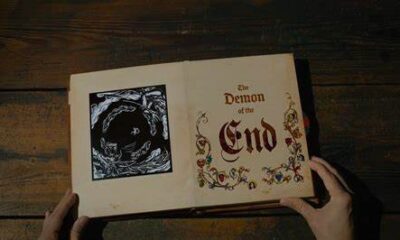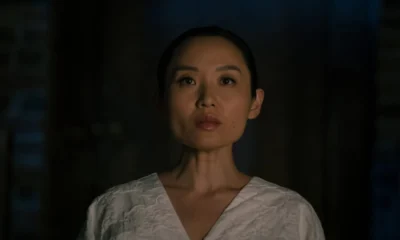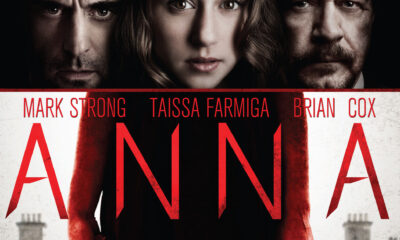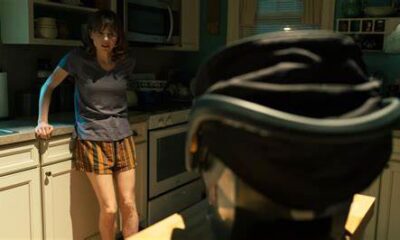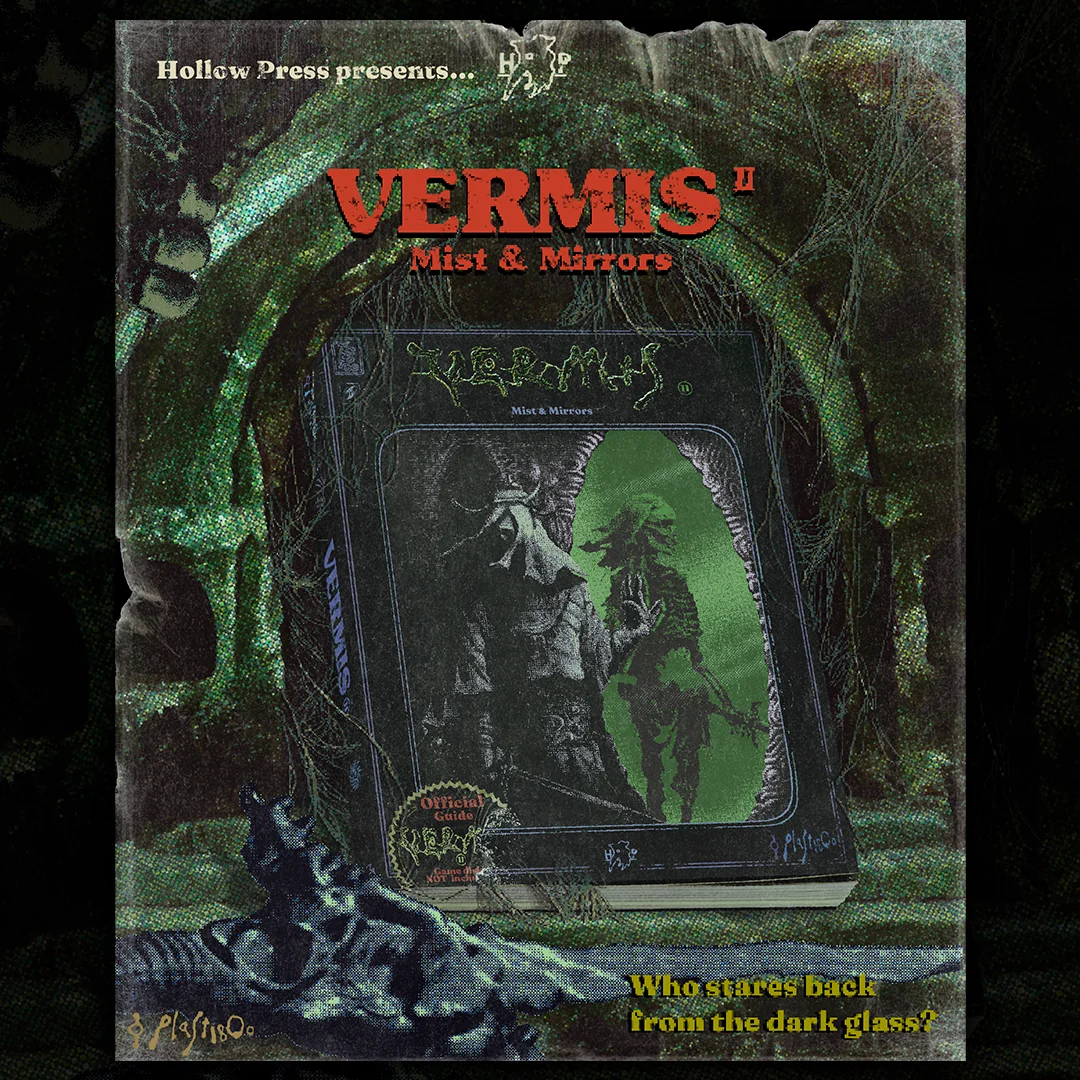
Vermis II: Mist & Mirrors, a Book Review
Vermis II: Mist & Mirrors is a graphic novel by Plastiboo, acting as the “official guide for a game that doesn’t exist.”
Vermis II: Mist & Mirrors is a graphic novel by Plastiboo. The team behind the work includes Plastiboo as the artist, Hollow Press as the publisher, Michele Nitri as the editor, Christian Dolz Bayarri as the graphic designer, Marco Cirillo Pedri as the graphic supervisor, and E.R. as the English editor and proofreader. The Vermis collection seems sold out in its current editions, but I still recommend ordering from the original publisher, Hollow Press.
Who stares back from the dark glass? The Wayfarer travels–cursed and haunted by their past–through the distant lands and places within the Mist & Mirrors. Endure a corrupt world and struggle to fend off the curses that mark you. Venture forth, Wayfarer, and perhaps find peace and salvation.
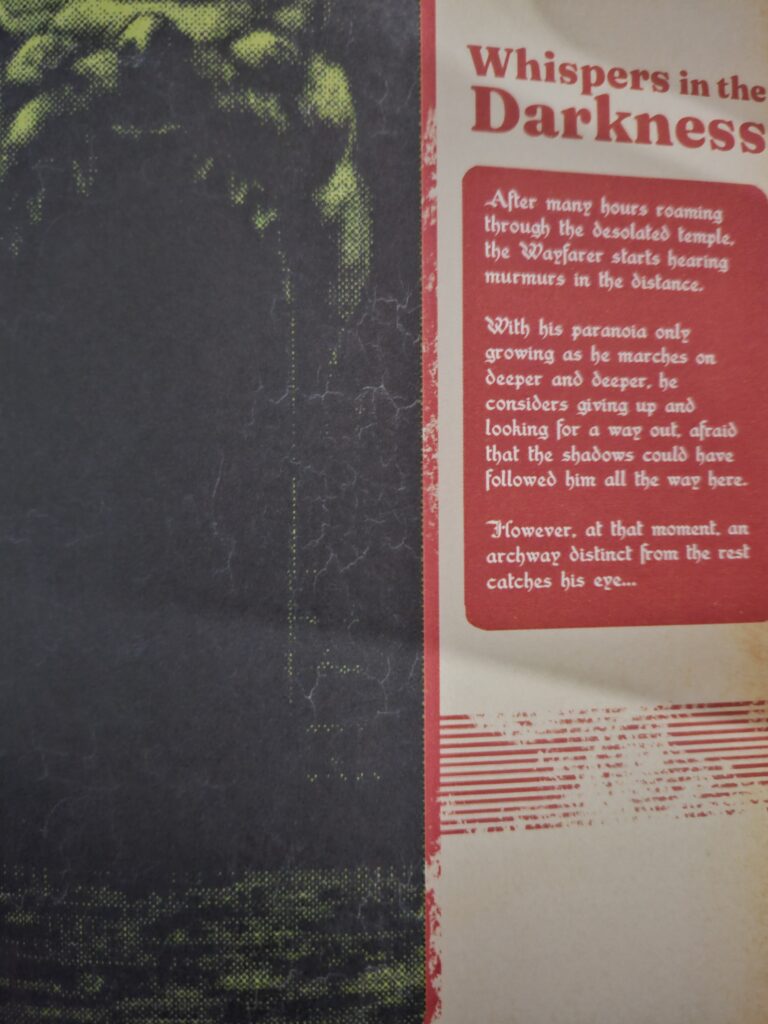
What I Like about Vermis II: Mist & Mirrors
The premise remains an “official guide” to a game that does not exist. However, one key distinction that stands out is the corrosion of this “official guide” mark, suggesting Mist & Mirrors centers itself as a graphic novel. In this sense, it more accurately hits its vision while providing an engaging story.
Mist & Mirrors places its character selection at the end of the graphic novel, instead, choosing a character and allowing the reader to follow that journey. While this moves away from the “official guide” concept, it better fleshes out the world and creates a more independent product.
Where Vermis I held a heavy retro-game aesthetic, Vermis II takes this to the next level while adding a wider range of color than the original. Not only does this add more aesthetic variety, but it also vastly improves readability. My greatest critique of the first graphic novel was the general lack of readability that impacted the experience, but Mist & Mirrors seems to take this to heart. Beyond the variety and improvement, the design changes the color themes to match the distinct lands the “Wayfarer” embarks on, giving a direct purpose to the changes.
On starting the graphic novel, I half expected a spiritual successor set in a new world. While its setting certainly differs from the original, Mist & Mirrors expands on the lore and history. In fact, the exploration of Mist & Mirrors adds value to the original and encourages a re-read. Honestly, that’s what all sequels strive (or should strive) to succeed.
Despite the colorful innovation, Vermis II: Mist & Mirrors delivers that same bleak horror popularized by Dark Souls. It still wears its inspirations on its sleeves while better communicating its “game mechanics.”

Tired Tropes and Triggers
Again, there aren’t many points worth mentioning regarding tropes or triggers. As the graphic novel takes themes and trends from the Soulslike genre, it’s dark and bleak but not overwhelmingly so.
Payment and delivery (for American audiences) still come with a 15 to 45-day wait period with little room for verification or updates. The process through PayPal remains seamless, and I received the novel within the timeframe, but it’s a consideration.

What I Dislike about Vermis II: Mist & Mirrors
While there are notable points to mention in this section, Mist & Mirror vastly mitigates Vermis I’s core issues. However, that isn’t inherently the same as fixing them in some cases. For example, readability remains a slight issue. I will emphasize it as a slight issue with the vast improvements implemented.
For those fans of the specific niche that Vermis aims to deliver, Mist & Mirrors tones down the “official guide” aspect. Instead, it favors a more straightforward narrative that follows a specific character. This brings life to the “game world” and makes an independent product but limits Vermis I’s game guide concept.
On a more personal note, I did enjoy the concept of Vermis I’s classes over the classes of Mist & Mirrors. Naturally, there are some interesting concepts, but nothing haunts me like the Infant Seeker or Rat Man. However, the new choices seem to provide a stronger narrative and backstory.

Final Thoughts
Vermis II: Mist & Mirrors vastly improves in many aspects of the original, telling a story set in its bleak and fascinating world. While it does veer from the original concept, it does so to make a more independent product. If you are looking to lose yourself in a strange world or dive deeper into Vermis’ underexplored lore, Mist & Mirrors seems tailor-made for you.
Book Reviews
A Stellar Debut Novel, We Used To Live Here
Imagine this. You’re home alone, waiting for your partner to return, when you hear a knock on your door. You answer it to see a family of five, bundled up against the cold. The father, a kindly older gentleman, explains that he used to live in this house as a boy. And he would love to show it to his family.
Do not let them in.
The story
Released in June 2024, We Used To Live Here is author Marcus Kliewer’s debut novel. It tells the story of Eve, who just purchased a beautiful house with her partner, Charlie. Their plan is to flip the house and sell it.
One night, while waiting for Charlie to come home, Eve is surprised by a knock at the door. It’s a man named Thomas Faust and his family.
Thomas explains that he grew up in the house and hasn’t been in the area in years. Would Eve let them in so that he can show the home to his children?
Against her better judgment, Eve lets them in. She regrets this almost at once when Thomas’s daughter vanishes somewhere into the house.
What worked
I always appreciate a book that allows you to play along with the mystery. And this book does that better than just about any other I’ve seen.
Pay close attention to the chapters, to the words that aren’t there. To everything about this novel.
This is mostly down to Kliewer. This is ultimately his work of art. But the production value is also fantastic. I don’t want to ruin the multiple mysteries, so I’ll just say this. There are clues in this book that require some specific artistic choices in the page layouts in this book. And I loved that.
If you’d like to experience another horror book review, check out this one.
We Used To Live Here is also the kind of story that makes you question everything right along with the main character, Eve. Eve is a great main character. But she might be an unreliable narrator. She might be experiencing every single horror described, exactly as it’s described. Or, she might be having a psychotic breakdown. Through most of the book, we can’t be sure. And that is so much fun.
Finally, the weather plays a large part in this story. There are several stories in which the weather or the land itself could be considered a character. Even an antagonist. This is certainly one. The winter storm is the thing that traps the family in the house with Eve. It also makes escaping the home difficult. Reading this book during the winter was especially impactful. Most of us know what it feels like to be shut in by a storm. I’ve personally lived through some of those storms that are just referred to by their year, as though they were impactful enough to claim the whole 365 days for themself. And that was with people I liked. Imagine what it would feel like with strangers. It’s a staggering thought and one that we explore in depth in this book.
- Get Out meets Parasite in this eerily haunting debut and Reddit hit—soon to be a Netflix original movie starring Blake Lively—about two homeowners whose lives are turned upside down when the house’s previous residents unexpectedly visit
- As a young, queer couple who flip houses, Charlie and Eve can’t believe the killer deal they’ve just gotten on an old house in a picturesque neighborhood
- As they’re working in the house one day, there’s a knock on the door
Last update on 2025-03-08 / Affiliate links / Images from Amazon Product Advertising API
In the end, We Used To Live Here is a fantastic book. It’s the sort of story that sneaks into your brain and puts down roots. And if this is just the first book we’re getting from Kliewer, I can’t wait to see what else he comes up with.
 (5 / 5)
(5 / 5)
Book Reviews
Exploring real terror with The House of My Mother
As a disclaimer, this is a review of The House of My Mother from a critical perspective. I will not be discussing my opinions of the legal case against Ruby Franke and Jody Hildebrandt. I will be discussing the merits of the book as a work of true crime alone.
In 2015, Ruby Franke started a YouTube channel called 8 Passengers. In August of 2023, Franke and her business associate Jodi Hildebrandt were arrested for, and later plead guilty to, charges of aggravated child abuse. And in January of this year, Shari Franke told her story in The House of My Mother.
The story
The House of My Mother is the true story of Shari Franke, the oldest child of one of the most famous family vlogger families.
As a child, Shari came to the conclusion that her mother didn’t like her. Soon, she began to fear her mother’s anger.
Things got significantly worse when Ruby started their family vlog. All of the families most intimate moments were splashed across the internet for anyone to watch. This became a living nightmare for Shari.
Of course, that was only the start of the family nightmare. Because Ruby was about to meet someone who would reinforce all of the darkest parts of herself.
Eventually Shari manages to escape her home. But her younger siblings were still in her mother’s clutches. She had to save them, and her father, from the monster her mother had become.
What worked
Through the book, Shari only ever mentions the name of one of her siblings, Chad. This is because Chad is the only of her siblings that is an adult at the time of the publication.
There are children involved in this story. Children who’s lives and privacy have already been damaged. Shari didn’t want to do that to them again, and neither do I.
It probably won’t surprise you that this book is full of upsetting details. But not in the way you might imagine.
Nowhere in this book will you find gory details about the abuse the Franke kids suffered. And I consider that a good thing. Those sort of details are all fun and games when we’re talking fiction. When it’s real kids who are really living with the damage, it’s not a good time.
What you’ll find instead is a slew of more emotionally devastating moments. One that stuck with me is when Ruby’s mother gives her a pair of silk pajamas as a gift after Ruby gave birth to one of her babies. Shari asks Ruby if she’d bring her silk pajamas when she had a baby. Ruby responds that yes, when Shari becomes a mother they can be friends.
What a lovely way to make a little girl feel like she’s not worth anything unless she reproduces. And, if she does decide to have children, who is going to bring her silk pajamas?
- From eldest daughter Shari Franke, the shocking true story behind the viral 8 Passengers family vlog and the hidden abuse she suffered at the hands of her mother, and how, in the face of unimaginable pain, she found freedom and healing
- Shari Franke’s childhood was a constant battle for survival
- Her mother, Ruby Franke, enforced a severe moral code while maintaining a façade of a picture-perfect family for their wildly popular YouTube channel 8 Passengers, which documented the day-to-day life of raising six children for a staggering 2
Last update on 2025-03-02 / Affiliate links / Images from Amazon Product Advertising API
In the end, this isn’t a story about ghosts or demons. It’s not about a serial killer waiting on a playground or in the attic of an unsuspecting family. Instead, this is a story about things that really keep us up at night. It’s the story of a woman so obsessed with perfection that she drove away her eldest daughter. The story of a young woman who’s forced to watch from afar as her beloved brothers and sisters are terrorized and abandoned. These are the sorts of things that really keep us up at night. These are the real nightmares.
More than that, though, The House of My Mother is a story of survival. It’s about a family that was ripped apart and somehow managed to stitch itself back together again. It’s about a brave young woman who managed to keep herself safe and sane in the face of a nightmare. If you haven’t read it yet, I can’t recommend it enough.
For more like this, check out my review of Shiny Happy People.
 (5 / 5)
(5 / 5)
Book Reviews
Book Review of Boreal: an Anthology of Taiga Horror

Boreal: an Anthology of Taiga Horror is a collection of twenty-two haunting tales that dwell in the deepest darkest woods and frozen wastelands, edited by Katherine Silva and including Haunted MTL’s very own Daphne Fauber. Each story has even been gifted with its very own poster, hinting at the horrors to be found within it, bestowing a beautiful visual collection as well.
The tales are varied and touch upon the environment in new and different ways, each hearkening to a sort of epiphany or raised awareness. These stories exude both dread and wonder at the smallness of our human existence in contrast to the sacred world we have isolated from, sheltering ourselves in our comfortable houses with centralized heat and everything we could possibly need or want at the ready. The taiga becomes a sanctuary outside of our own dulled awarenesses. It is a holy place imbued with powers beyond mortal human reach, a wilderness that threatens to swallow us – both whole and bit by bit, simultaneously.
The protagonists enter into this realm through ritual, superstition, longing, stubbornness, and their own hubris – yearning to survive its dangers, and to make their own marks upon it. The starkness of their surroundings harbors delicate moments that would be all too easily missed if not deliberately sought or pointed out. The softness of fur, the dappled sunlight shining through trees, the hazy clouds of breath forming in crisp air, the brittleness of bleached bone… those quiet experiences that beg to be forgotten, to lay safely sleeping just below the frozen surface, awaiting spring.
There are those who followed in the footsteps of their predecessors, seeking to escape the constraints of their parent’s and elders’ indoctrination, traditions, madness, and abuse, yearning to find their own way despite also being inextricably bound to their own pasts. There are those who just wanted to go for a walk in the woods, and remained forever changed by what they experienced. There are those who wished to impose their will upon the wilderness, their order falling to disarray, unable to make lasting impact. There are those who sought to leave behind the world of mankind, looking for oneness in the natural order of things through isolation, leaving a bit of themselves behind after being consumed by the terrors they encountered. There are those who truly found communion with the woods, became one with its wildness, and invited its spirit into their hearts to find peace, even at cost of their own lives. And then, there are the spirits themselves…
 (3 / 5)
(3 / 5)
All in all, I give Boreal: an Anthology of Taiga Horror 3.0 Cthulhus. I love existential angst so I found it to be an enjoyable read, and I appreciated the myriad manners in which the biome was explored. But there were points in which I found myself struggling to follow along, as if the words were swept up into their own wilds in ways that alienated myself as reader, as if my mere voyeurism into this otherworldly place was not enough to comprehend the subtle deviations in storytelling mannerisms fully. I suppose in some sense this seems appropriate, but at the same time, it left me feeling a bit unfulfilled, as if I had missed a spiritual connection that should have resonated more deeply.
- English (Publication Language)
- 248 Pages – 02/25/2025 (Publication Date) – Strange Wilds Press (Publisher)
Last update on 2025-01-23 / Affiliate links / Images from Amazon Product Advertising API




